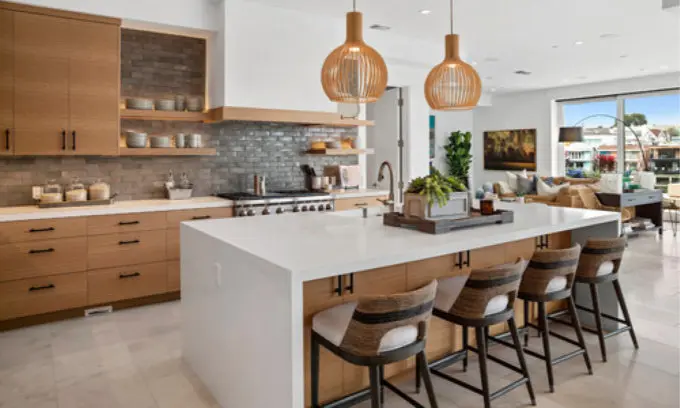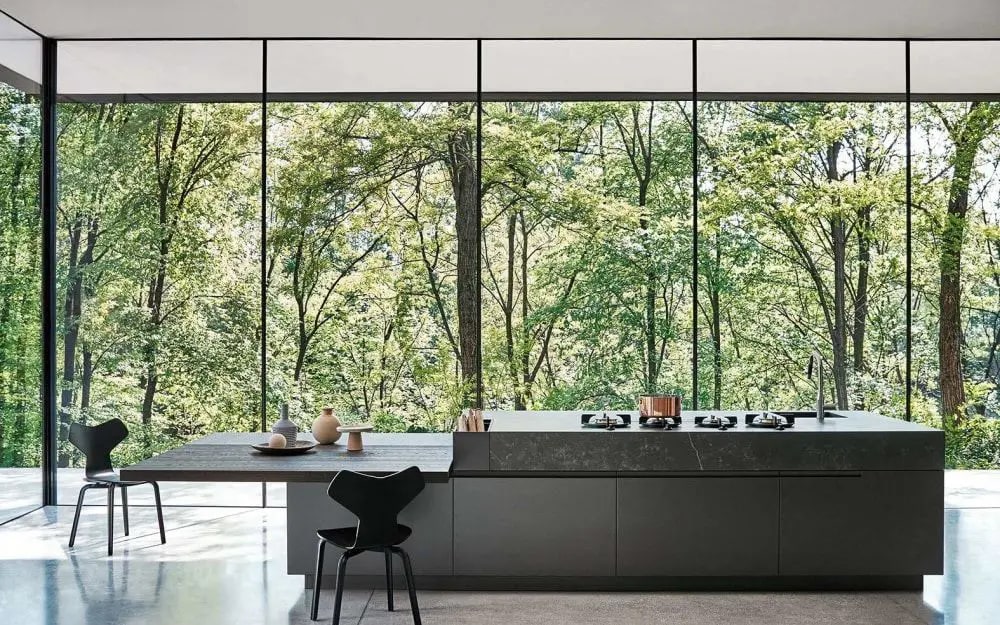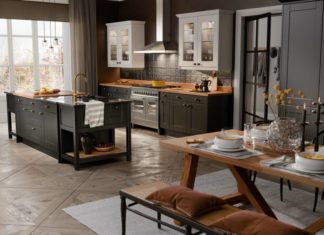In the new decade of 2020, interior designers are looking towards the environment for inspiration within our own homes. Previously, bringing nature into the room would be as simple as adding flowers or wallpapering with sunflowers. Yet technological advances and understanding how the environment affects our mood have created a new interior style: Biophilic Kitchen Design.
Designers using this approach create rooms knowing how the human body responds to the rhythm of the world and nature. This style creates more calm in interiors, helps creativity, and companies like Google and Apple use this for their workspaces. Potential other benefits also include feeling more alert and productive.
So what are some tips for incorporating a biophilic kitchen in 2020? Here are some suggestions to add this new trend with positive benefits into your home:
Circadian Lighting
 photo: Encompass Cayman
photo: Encompass CaymanWhat if your house structure doesn’t have large windows, or even no windows, to add natural light into your kitchen? Biophilic design includes the concept of circadian lighting, referencing our body’s waking and sleeping patterns and energy throughout the day. Circadian rhythms are affected by light cues, sending signals to your brain to be more awake or to become tired.
Circadian lighting changes intensity and color matching the outside daylight by mimicking it in interiors. As we notice in nature, the sun is too bright at noon, but we can see sunsets with orange glows. These distinctive lights can create this feeling in your biophilic kitchen, impacting your overall health.
Natural surfaces for cabinets
 photo: Habitus Living
photo: Habitus LivingThe choice of materials for major structures will largely contribute to the overall feel of your kitchen. Natural materials and textures are becoming more popular this year for cabinets and countertops. Many variations of wood in cabinets range from dark brown walnut to creamy maple are neutrals fitting into any home. More than colors, wood grain brings the texture of trees into the kitchen and become subtle, minimal design.
Stone countertops such as granite and marble are becoming favored, not just for their feel but for their veining. Since granite and marble are more expensive, alternatives made from acrylic can reproduce the look but are more scratch-resistant. However, quartz can give you the feel without as much veining and it more durable and affordable.
Textured backsplash inspired by the living world
 photo: Standard Tile NJ
photo: Standard Tile NJBacksplashes have been that area that interior designers feel can be a creative space that personalizes the interior. Even if the room is full of solid slab colors, backsplashes break up the monotony of a sterile room. While wallpapers can serve the same effect, backsplashes are centered focal point of a room. You can add a point of interest without committing the entire place to that pattern.
For the biophilic look, there a large variety of how to add nature to the room. You can add stone tiles or wood details, but you can also insert images of plants, flowers, or animals. The details do not have to be literal portraits to convey nature. The representation of flowing water or the fractal veining of leaves can work well as backsplash texture.
Vertical Garden
 photo: Zensa Design
photo: Zensa DesignOne of the biggest trends projected in homes is the vertical garden, creating wall décor with plant life. With most interior designer sites embracing this aesthetic, these plants are plastic for practical reasons. If you have real plants, you’re dealing with dirt, watering, and positioning them for sunlight, which is messy to maintain. The suggestion of plants, real or artificial, brings an intimate level of the outside to your interiors.
For the kitchen, the vertical garden is a unique opportunity to grow a practical herb garden. You can add a real vertical herb garden the size of a bulletin board or real texture and visual interest. This is especially great for cooks who can use the freshest verbs in their cooking. It is crucial you find a solution for the drainage of this herb box so that you can maintain it.
Large windows and natural lighting
 photo: Pinterest
photo: PinterestThe presence of windows brings in more natural light, which is often preferred in any kitchen interior. Natural sunlight brightens the room and likewise brightens your mood. While sunlight isn’t the only lighting consideration for the kitchen, you need evening illumination. Night lighting in the kitchen should not be strong as daylight, but it should be bright enough to prepare food.
While we want maximum sunlight, it doesn’t mean doing away with drapery or curtains. Fibers like linen can either be sheer to add light or more substantial to control light in the space. Horizontal or vertical blinds are available in wood textures, and even roman blinds add more natural cover to the area.
Flooring
 photo: Velacreative
photo: VelacreativeThe ground is a strong foundation for anything in nature and is particularly true in the biophilic kitchen. There are many options of wood flooring available on the market from hardwood planks to vinyl tiles with wood grain. While marble and granite tiles are natural, if they are glossy, they feel less natural because they are too polished. Matte tiles are preferred since most stone that you find outside is not reflective. Yet an unexpected floor material that is biophilic: concrete. Concrete is composed of rock and sand, so the feel the firm connection to the Earth beneath your feet.





